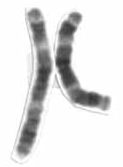| Chromosome 3 | |
|---|---|
 Human chromosome 3 pair after G-banding. One is from mother, one is from father. | |
 Chromosome 3 pair in human male karyogram. | |
| Features | |
| Length (bp) | 201,105,948 bp (CHM13) |
| No. of genes | 1,024 (CCDS) [1] |
| Type | Autosome |
| Centromere position | Metacentric [2] (90.9 Mbp [3] ) |
| Complete gene lists | |
| CCDS | Gene list |
| HGNC | Gene list |
| UniProt | Gene list |
| NCBI | Gene list |
| External map viewers | |
| Ensembl | Chromosome 3 |
| Entrez | Chromosome 3 |
| NCBI | Chromosome 3 |
| UCSC | Chromosome 3 |
| Full DNA sequences | |
| RefSeq | NC_000003 (FASTA) |
| GenBank | CM000665 (FASTA) |
Chromosome 3 is one of the 23 pairs of chromosomes in humans. People normally have two copies of this chromosome. Chromosome 3 spans more than 201 million base pairs (the building material of DNA) and represents about 6.5 percent of the total DNA in cells.

